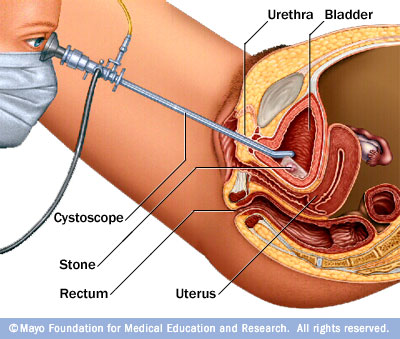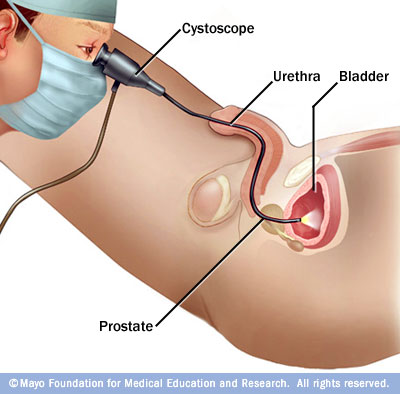A simple outpatient cystoscopy may take less than five minutes. When done in a hospital setting with sedation or general anesthesia, cystoscopy can take 10 to 30 minutes. Your cystoscopy procedure may follow this process:
-
You'll be asked to empty your bladder before the procedure. Then you'll lie down on a table on your back. You'll likely be positioned with your feet in stirrups and your knees bent.
-
You may or may not need a sedative or anesthetic. If you receive a sedative, you'll feel sleepy and relaxed during the cystoscopy, but you'll still be aware. If you receive a general anesthetic, you won't be aware during the procedure. Both types of medication may be given through a vein in your arm.
-
Your doctor will insert the cystoscope. A numbing jelly will be applied to your urethra to help prevent pain when the cystoscope is inserted. After waiting a few minutes for the numbing, your doctor will carefully push the cystoscope into your urethra, using the smallest scope possible. Smaller scopes are often used to look for causes of signs and symptoms. Larger scopes may be necessary to take tissue samples or pass surgical tools into the bladder.
-
Your doctor will examine your urethra and bladder. As the cystoscope passes through your urethra and toward your bladder, your doctor will look through a lens on the end of the cystoscope. The lens works like a telescope to magnify the inner surfaces of your urethra and your bladder. In some cases, your doctor may place a special video camera over the lens that projects the images onto a video screen.
-
Your doctor will fill your bladder with a sterile solution. Once the cystoscope reaches your bladder, your doctor will flood the bladder with a sterile solution. The solution inflates the bladder and allows your doctor to get a better look inside. As your bladder fills, you may feel the need to urinate. As soon as your cystoscopy is complete, you'll be allowed to empty your bladder.
-
Your doctor may take tissue samples or perform another procedure. Depending on your situation, your doctor may take tissue samples for lab testing or perform various procedures during the cystoscopy.
After the cystoscopy
After your cystoscopy, you may be allowed to go about your day. If you've been given sedation or general anesthesia, you may be asked to remain in a recovery area to let the effects of the medication wear off before you leave.
You might experience some side effects after cystoscopy, such as:
-
Bleeding from your urethra, which may appear bright pink in your urine or on toilet tissue
-
A burning sensation during urination
-
More frequent urination for the next day or two
You can relieve some of the discomfort if you:
-
Hold a warm, moist washcloth over the opening to your urethra to help relieve pain. Repeat this as needed.
-
Take a warm bath. Though, in some cases, your doctor may ask you to avoid baths. If you have concerns, call your doctor.
-
Drink water to flush out your bladder. This may reduce irritation. Try to drink 16 ounces (473 milliliters) of water each hour for the first two hours after your cystoscopy.
Call your doctor if you have concerns after your cystoscopy.

